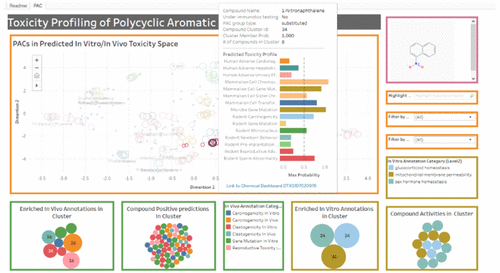当前位置:
X-MOL 学术
›
Chem. Res. Toxicol.
›
论文详情
Our official English website, www.x-mol.net, welcomes your
feedback! (Note: you will need to create a separate account there.)
Harnessing In Silico, In Vitro, and In Vivo Data to Understand the Toxicity Landscape of Polycyclic Aromatic Compounds (PACs)
Chemical Research in Toxicology ( IF 3.7 ) Pub Date : 2020-10-16 , DOI: 10.1021/acs.chemrestox.0c00213 Jui-Hua Hsieh 1 , Alexander Sedykh 2 , Esra Mutlu 1 , Dori R Germolec 1 , Scott S Auerbach 1 , Cynthia V Rider 1
Chemical Research in Toxicology ( IF 3.7 ) Pub Date : 2020-10-16 , DOI: 10.1021/acs.chemrestox.0c00213 Jui-Hua Hsieh 1 , Alexander Sedykh 2 , Esra Mutlu 1 , Dori R Germolec 1 , Scott S Auerbach 1 , Cynthia V Rider 1
Affiliation

|
Polycyclic aromatic compounds (PACs) are compounds with a minimum of two six-atom aromatic fused rings. PACs arise from incomplete combustion or thermal decomposition of organic matter and are ubiquitous in the environment. Within PACs, carcinogenicity is generally regarded to be the most important public health concern. However, toxicity in other systems (reproductive and developmental toxicity, immunotoxicity) has also been reported. Despite the large number of PACs identified in the environment, research attention to understand exposure and health effects of PACs has focused on a relatively limited subset, namely polycyclic aromatic hydrocarbons (PAHs), the PACs with only carbon and hydrogen atoms. To triage the rest of the vast number of PACs for more resource-intensive testing, we developed a data-driven approach to contextualize hazard characterization of PACs, by leveraging the available data from various data streams (in silico toxicity, in vitro activity, structural fingerprints, and in vivo data availability). The PACs were clustered on the basis of their in silico toxicity profiles containing predictions from 8 different categories (carcinogenicity, cardiotoxicity, developmental toxicity, genotoxicity, hepatotoxicity, neurotoxicity, reproductive toxicity, and urinary toxicity). We found that PACs with the same parent structure (e.g., fluorene) could have diverse in silico toxicity profiles. In contrast, PACs with similar substituted groups (e.g., alkylated-PAHs) or heterocyclics (e.g., N-PACs) with varying ring sizes could have similar in silico toxicity profiles, suggesting that these groups are better candidates for toxicity read-across analysis. The clusters/regions associated with certain in silico toxicity, in vitro activity, and structural fingerprints were identified. We found that genotoxicity/carcinogenicity (in silico toxicity) and xenobiotic homeostasis and stress response (in vitro activity), respectively, dominate the toxicity/activity variation seen in the PACs. The “hot spots” with enriched toxicity/activity in conjunction with availability of in vivo carcinogenicity data revealed regions of either data-poor (hydroxylated-PAHs) or data-rich (unsubstituted, parent PAHs) PACs. These regions offer potential targets for prioritization of further in vivo assessment and for chemical read-across efforts. The analysis results are searchable through an interactive web application (https://ntp.niehs.nih.gov/go/pacs_tableau), allowing for alternative hypothesis generation.
中文翻译:

利用硅胶、体外和体内数据了解多环芳烃化合物 (PAC) 的毒性情况
多环芳族化合物 (PAC) 是具有最少两个六原子芳族稠环的化合物。PAC 产生于有机物的不完全燃烧或热分解,在环境中无处不在。在 PAC 中,致癌性通常被认为是最重要的公共卫生问题。然而,其他系统的毒性(生殖和发育毒性、免疫毒性)也有报道。尽管在环境中发现了大量 PAC,但了解 PAC 的暴露和健康影响的研究注意力集中在相对有限的子集上,即多环芳烃 (PAH),即只有碳原子和氢原子的 PAC。为了对其余的大量 PAC 进行分类以进行更多资源密集型测试,我们开发了一种数据驱动的方法,通过利用来自各种数据流(计算机毒性、体外活性、结构指纹和体内数据可用性)的可用数据,将 PAC 的危险特征置于情境中。PACs 是基于它们的计算机毒性概况进行聚类的,其中包含来自 8 个不同类别(致癌性、心脏毒性、发育毒性、遗传毒性、肝毒性、神经毒性、生殖毒性和泌尿毒性)的预测。我们发现具有相同母体结构(例如芴)的 PAC 可能具有不同的硅毒性特征。相比之下,具有相似取代基团(例如烷基化多环芳烃)或具有不同环大小的杂环(例如 N-PAC)的 PAC 可能具有相似的硅毒性特征,表明这些组是毒性交叉分析的更好候选者。确定了与某些计算机毒性、体外活性和结构指纹相关的簇/区域。我们发现遗传毒性/致癌性(计算机毒性)和异生物稳态和应激反应(体外活性)分别支配着 PAC 中所见的毒性/活性变化。具有丰富毒性/活性的“热点”以及体内致癌性数据的可用性揭示了数据贫乏(羟基化多环芳烃)或数据丰富(未取代的母多环芳烃)PAC 的区域。这些区域为进一步体内评估和化学交叉研究的优先排序提供了潜在的目标。分析结果可通过交互式 Web 应用程序 (https://ntp.niehs.
更新日期:2020-10-16
中文翻译:

利用硅胶、体外和体内数据了解多环芳烃化合物 (PAC) 的毒性情况
多环芳族化合物 (PAC) 是具有最少两个六原子芳族稠环的化合物。PAC 产生于有机物的不完全燃烧或热分解,在环境中无处不在。在 PAC 中,致癌性通常被认为是最重要的公共卫生问题。然而,其他系统的毒性(生殖和发育毒性、免疫毒性)也有报道。尽管在环境中发现了大量 PAC,但了解 PAC 的暴露和健康影响的研究注意力集中在相对有限的子集上,即多环芳烃 (PAH),即只有碳原子和氢原子的 PAC。为了对其余的大量 PAC 进行分类以进行更多资源密集型测试,我们开发了一种数据驱动的方法,通过利用来自各种数据流(计算机毒性、体外活性、结构指纹和体内数据可用性)的可用数据,将 PAC 的危险特征置于情境中。PACs 是基于它们的计算机毒性概况进行聚类的,其中包含来自 8 个不同类别(致癌性、心脏毒性、发育毒性、遗传毒性、肝毒性、神经毒性、生殖毒性和泌尿毒性)的预测。我们发现具有相同母体结构(例如芴)的 PAC 可能具有不同的硅毒性特征。相比之下,具有相似取代基团(例如烷基化多环芳烃)或具有不同环大小的杂环(例如 N-PAC)的 PAC 可能具有相似的硅毒性特征,表明这些组是毒性交叉分析的更好候选者。确定了与某些计算机毒性、体外活性和结构指纹相关的簇/区域。我们发现遗传毒性/致癌性(计算机毒性)和异生物稳态和应激反应(体外活性)分别支配着 PAC 中所见的毒性/活性变化。具有丰富毒性/活性的“热点”以及体内致癌性数据的可用性揭示了数据贫乏(羟基化多环芳烃)或数据丰富(未取代的母多环芳烃)PAC 的区域。这些区域为进一步体内评估和化学交叉研究的优先排序提供了潜在的目标。分析结果可通过交互式 Web 应用程序 (https://ntp.niehs.











































 京公网安备 11010802027423号
京公网安备 11010802027423号